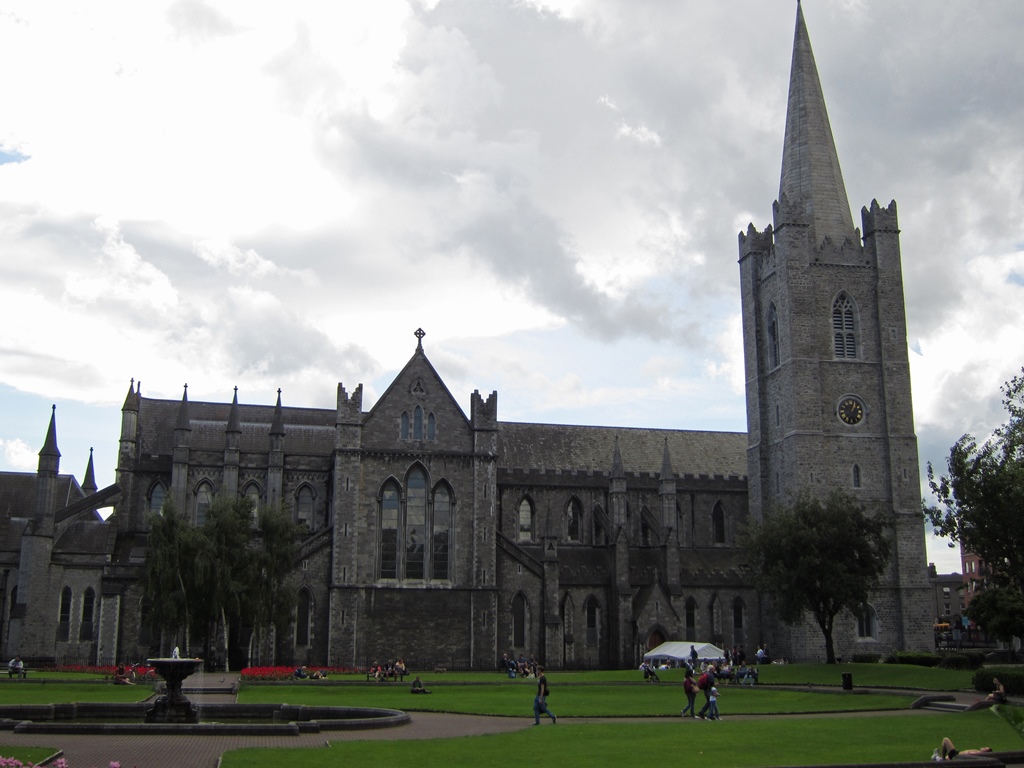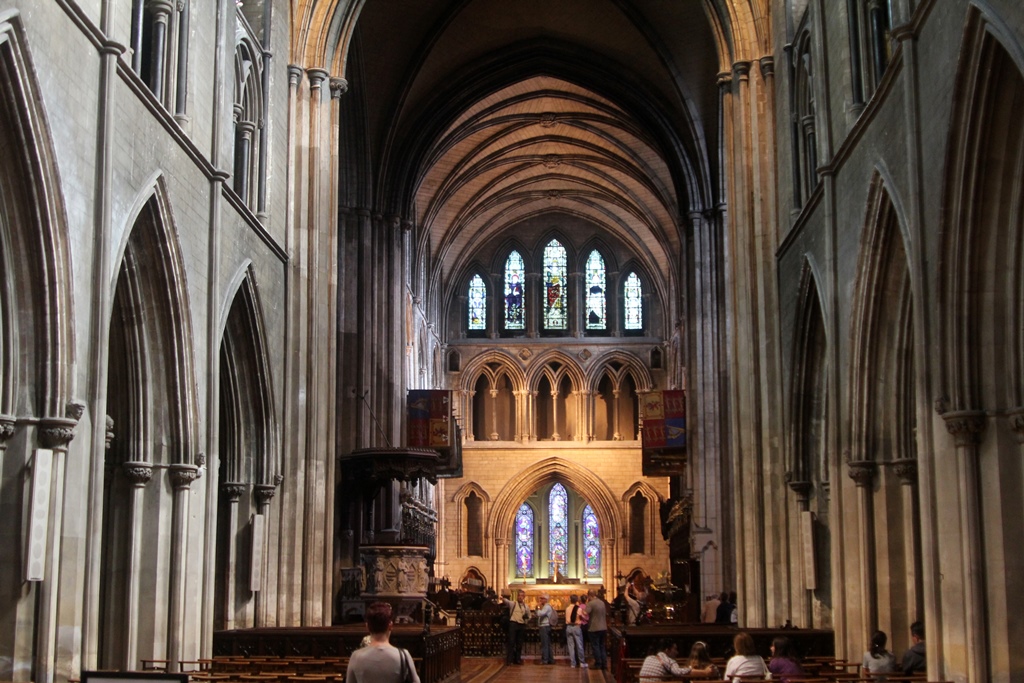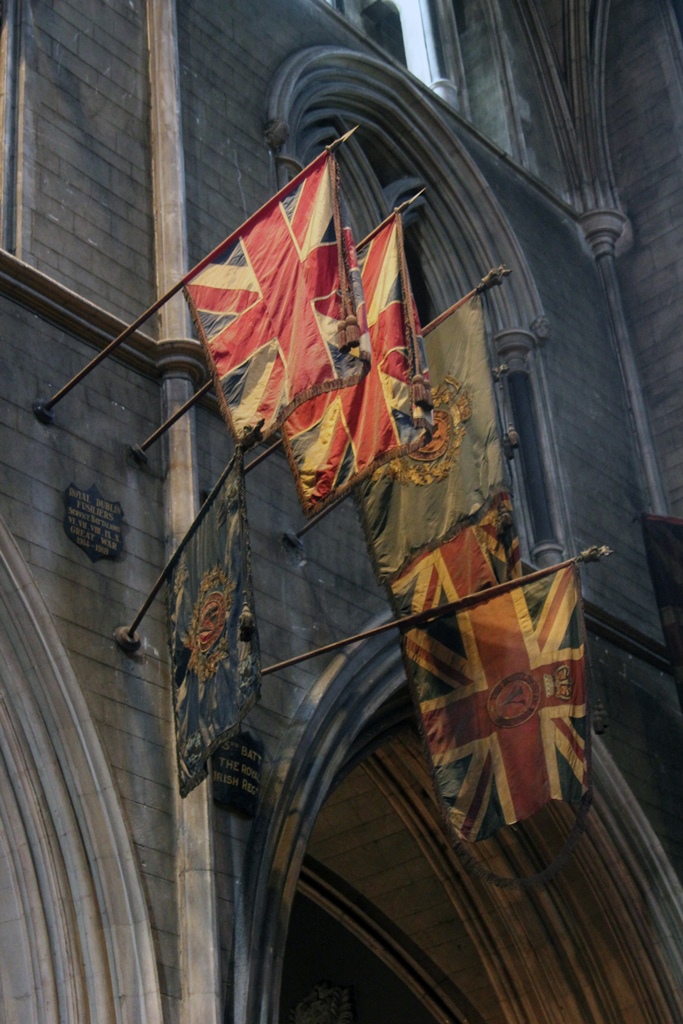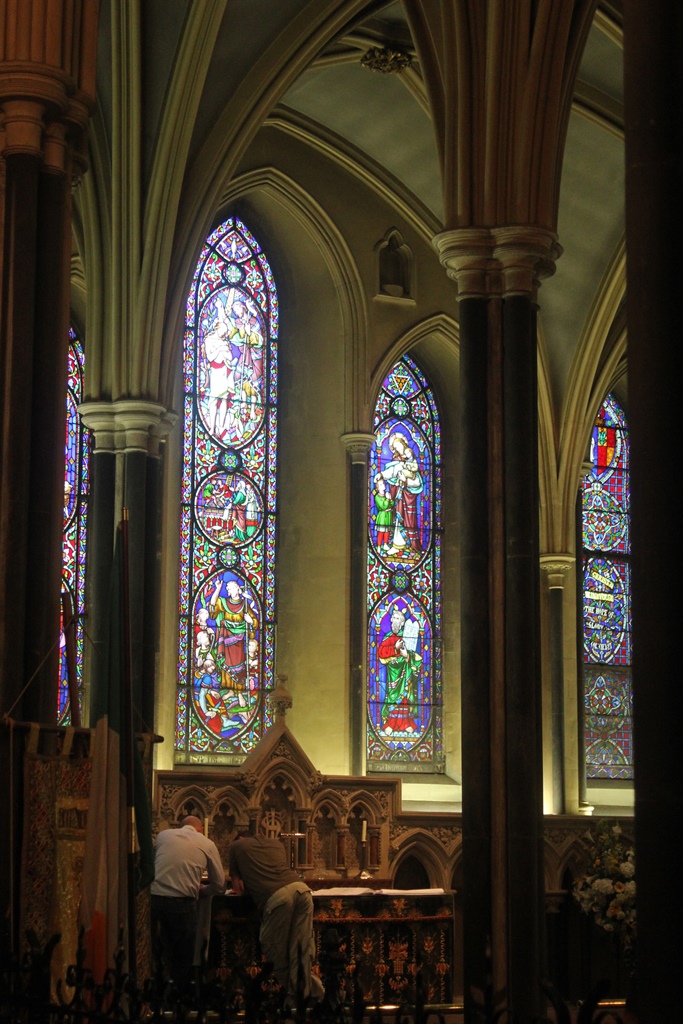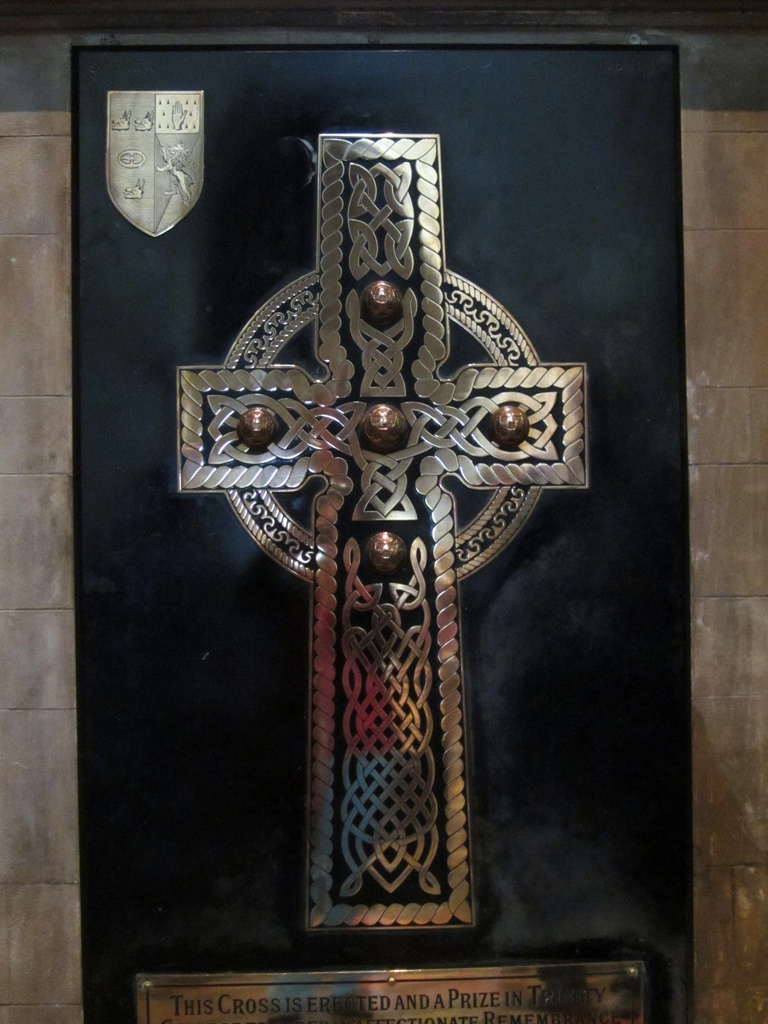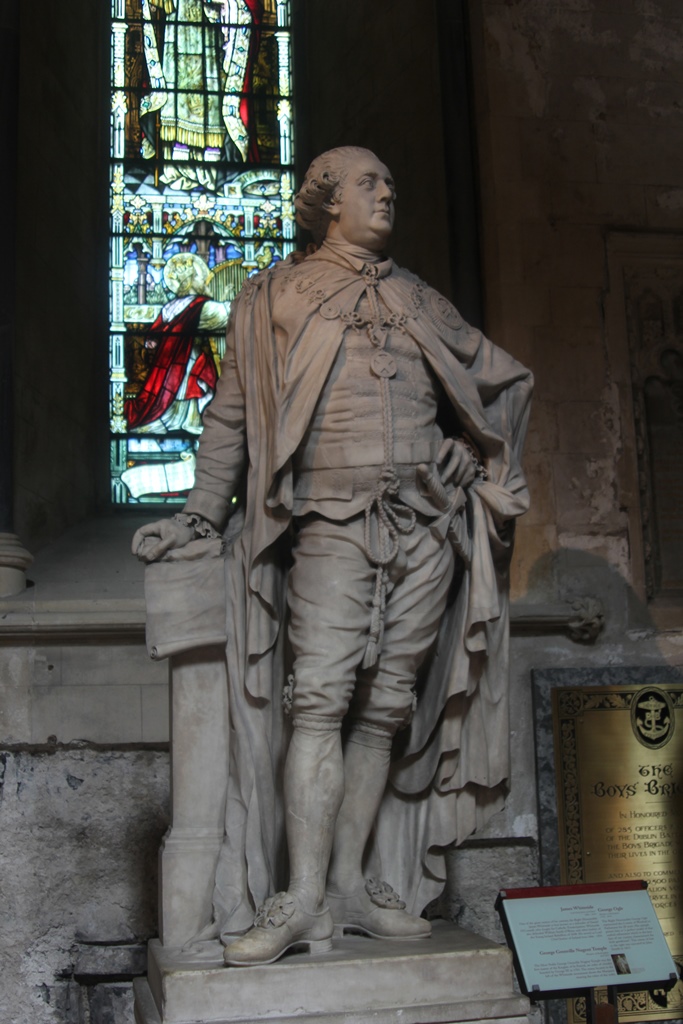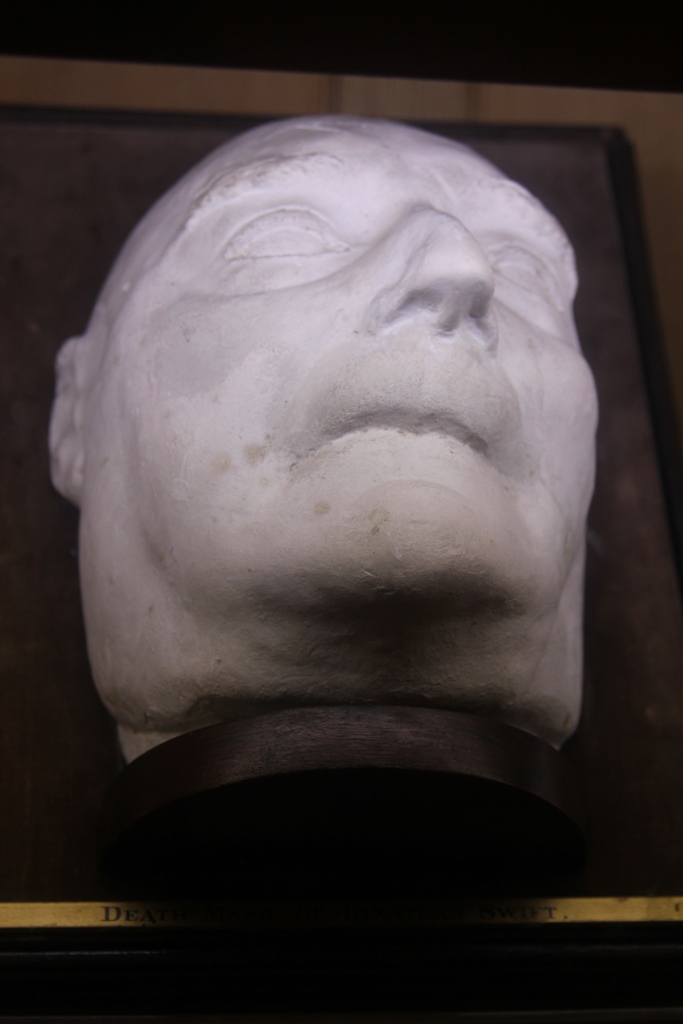St. Patrick's Cathedral
The
National Cathedral and Collegiate Church of Saint Patrick
is the largest church
in Ireland and the National Cathedral for the Church of Ireland. It is situated in
a fork of the River Poddle (now underground), and is thought to be next to a well
used for baptisms in the 5th Century by St. Patrick. During the 1901 construction
of the garden next to the cathedral, six Celtic grave slabs dating to the 10th
Century were found. One of the slabs was covering the remains of an ancient well,
and it's thought that this may have been the very well used by the Saint.
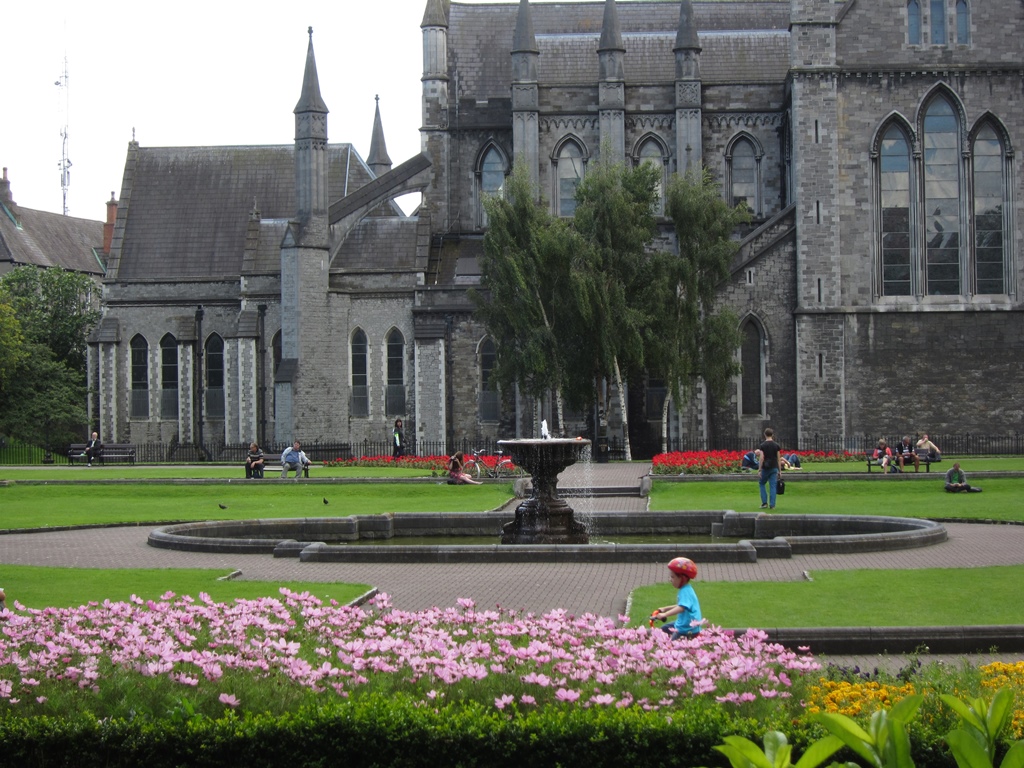
Garden Fountain
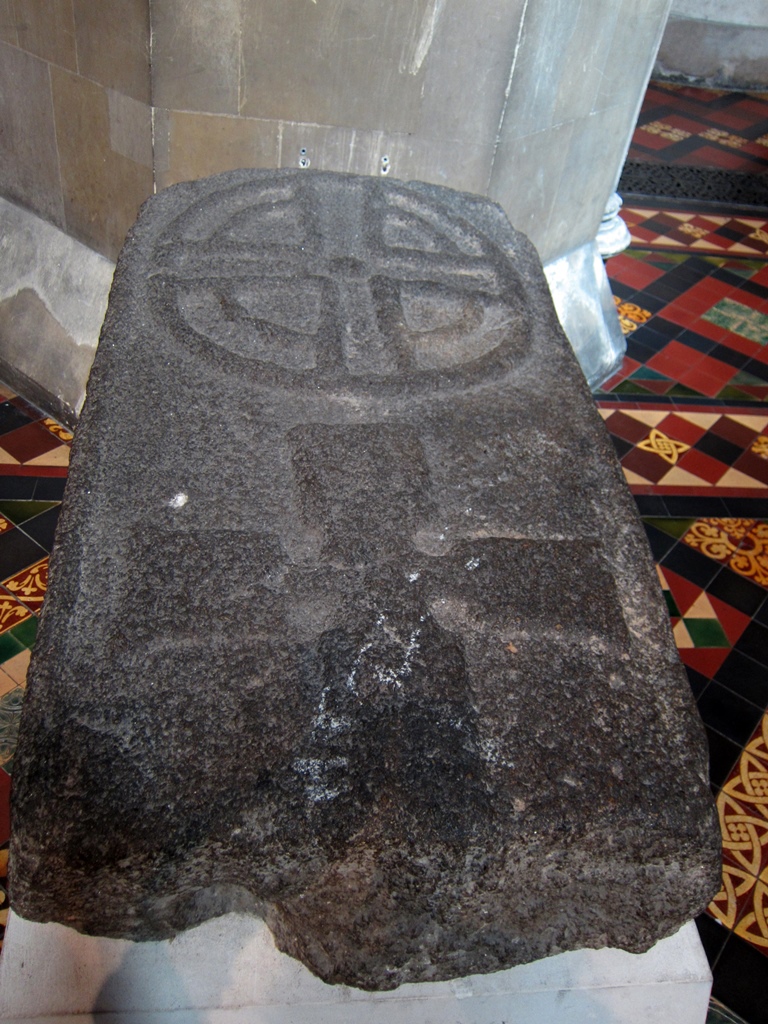
9th-11th Century Grave Marker
The church was founded in 1191, but the building from which the present one
evolved was built in the early-mid 13th Century. Over the centuries there have
been additions and collapses and fires and even floods (the water table is only
7 feet below the floor of the cathedral, making a crypt out of the question).
In the 17th Century, Oliver Cromwell stabled horses in the cathedral nave. But
all the periods of deterioration have been followed by restorations, with the
most recent big one coming courtesy of the Guinness family – mainly Benjamin
Lee Guinness, whose badly-needed 1860-65 restoration was done under the condition
that it not be interfered with. Many things were done during this restoration,
including the addition of a ceiling (separate from the underside of the roof) and
the removal of wooden partitions which separated parts of the church from each
other. Eventual reviews of the work were not unanimous, but the cathedral board
must not have been too upset – the cathedral was reopened in 1865 with an
elaborate ceremony, and a bronze statue of Sir Benjamin was put up outside the
south side of the cathedral in 1875.
The south side of the cathedral is also where we found the entrance. We paid the
admission fee (regular maintenance is now done with the help of these fees) and
walked in. To our left we couldn't help but notice a tall, dark-colored monument
against the wall (the Boyle monument – more on this later), and, in front of us,
a small gift shop (also to help with the maintenance expenses, no doubt).
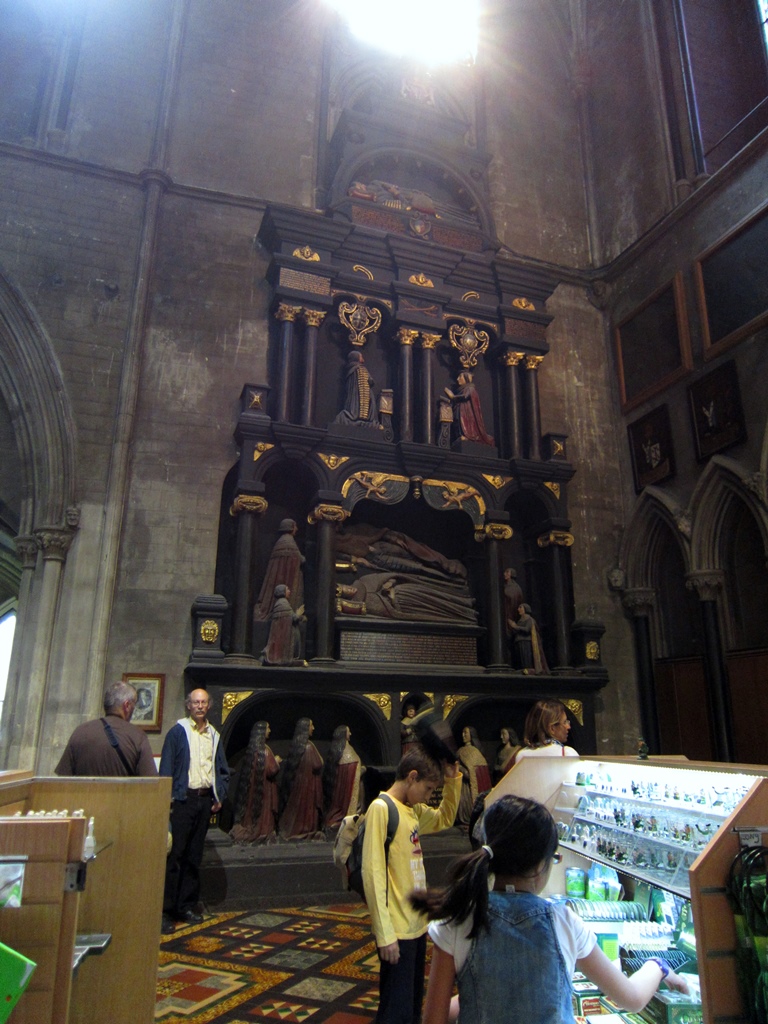
Bob, Boyle Monument, Gift Shop
To the right was the bulk of the cathedral. We set off to explore.
The Nave
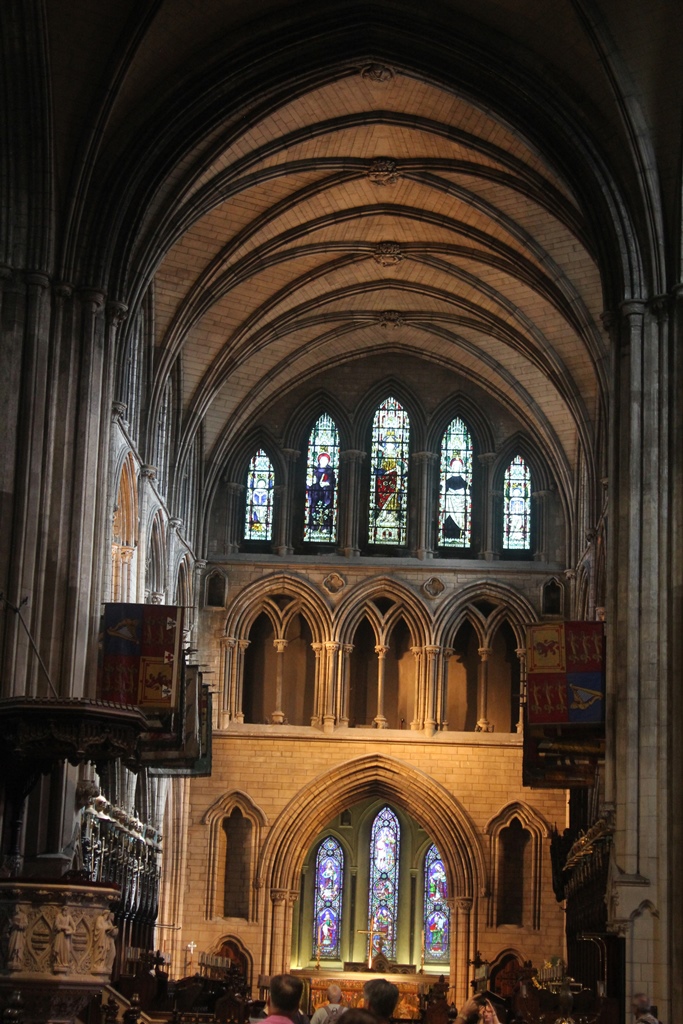
Main Altar and Choir
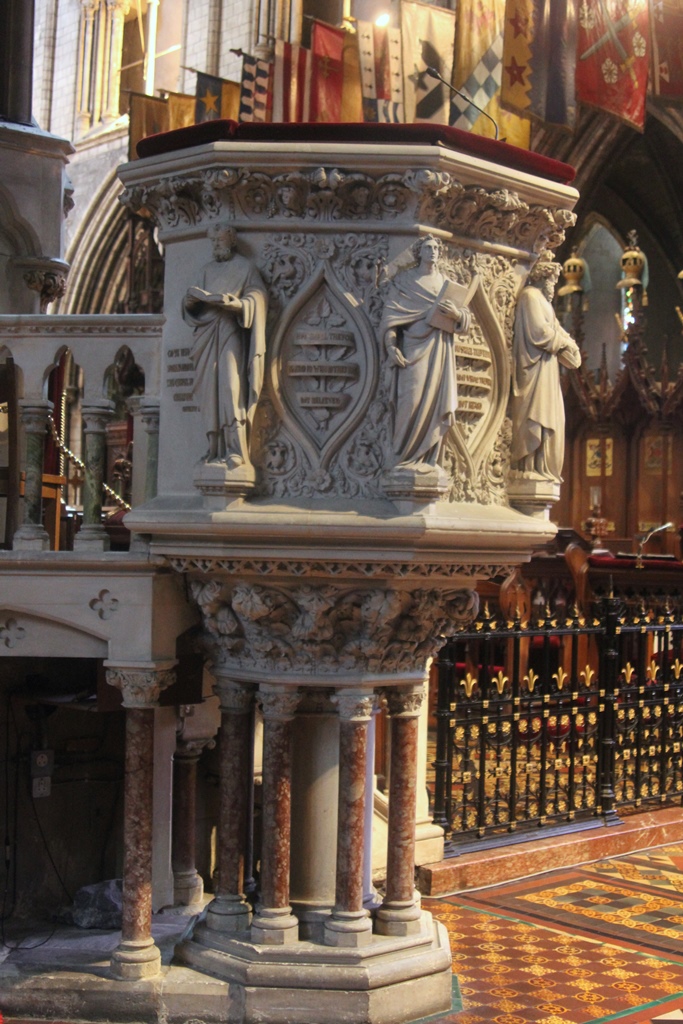
Pulpit
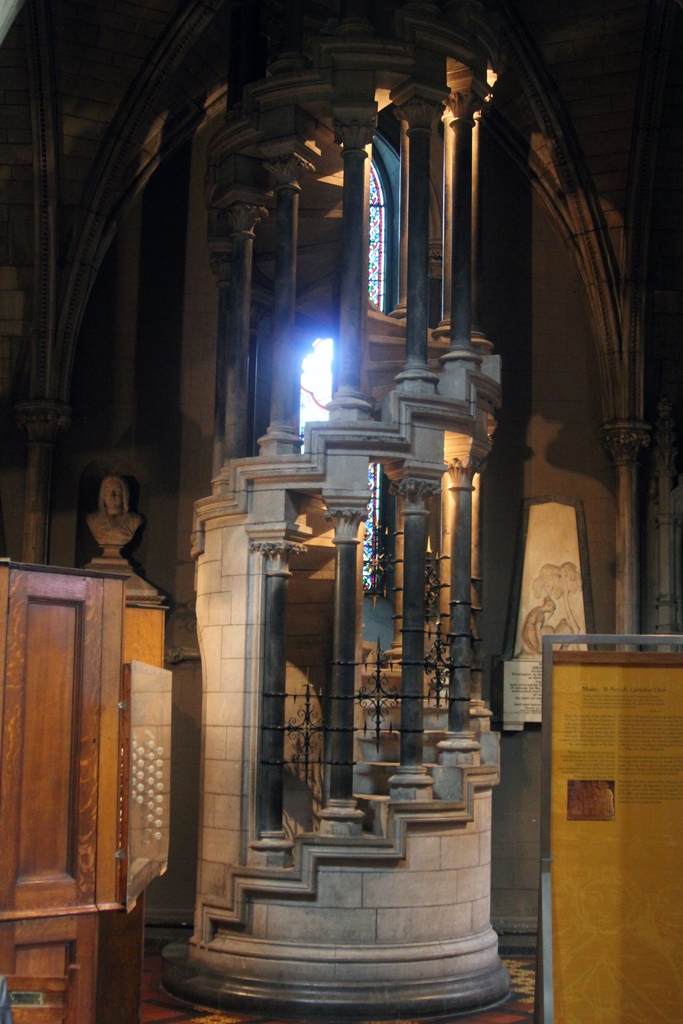
Staircase to Organ Loft
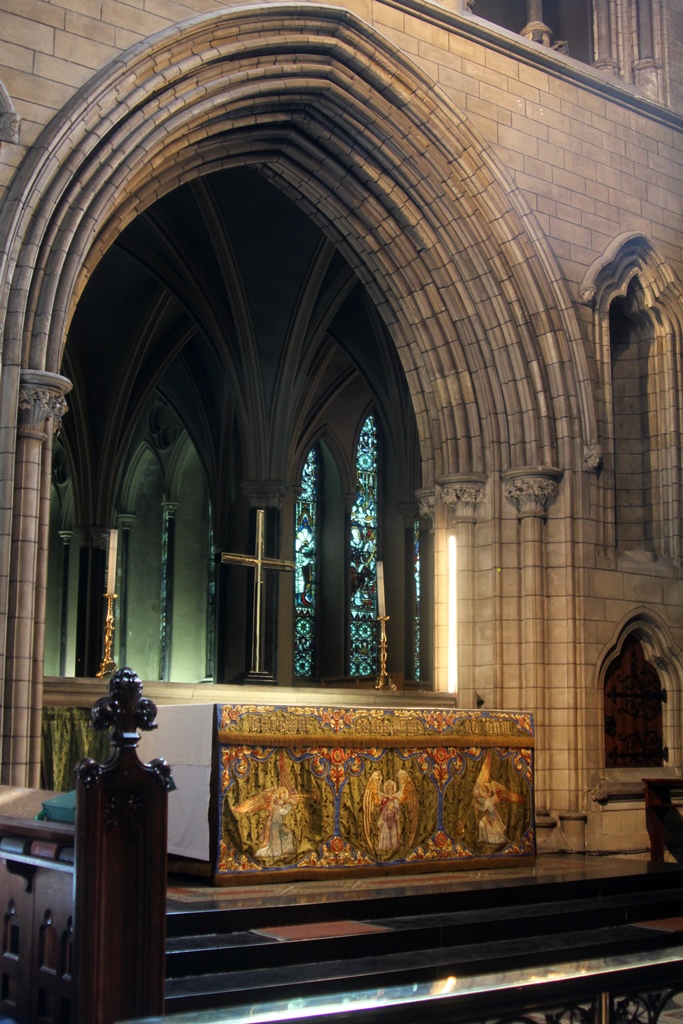
Main Altar
Near the front of the church, looking to our left up the north transept,
we noticed several flags hanging from the wall. Apparently the north
transept was set aside in the 19th Century to commemorate Irishmen who
died in the service of the British army, and the flags are regimental
flags representing some of the soldiers. Some of the flags are more than
100 years old.
Regimental Flags, North Transept
There were also flags hanging from the walls of the choir, in front
of us. These flags are family heralds representing membership in the
Most Illustrious Order of the Knights of Saint Patrick. This was an
order of chivalry founded in 1783 under King George III. In 1869,
ceremonies related to the order were moved to Dublin Castle, and the
flags above the choir stalls in St. Patrick's represent the order's
membership at that time. The order pretty much faded away after
Ireland gained independence from Britain, though technically Queen
Elizabeth II is still a member.
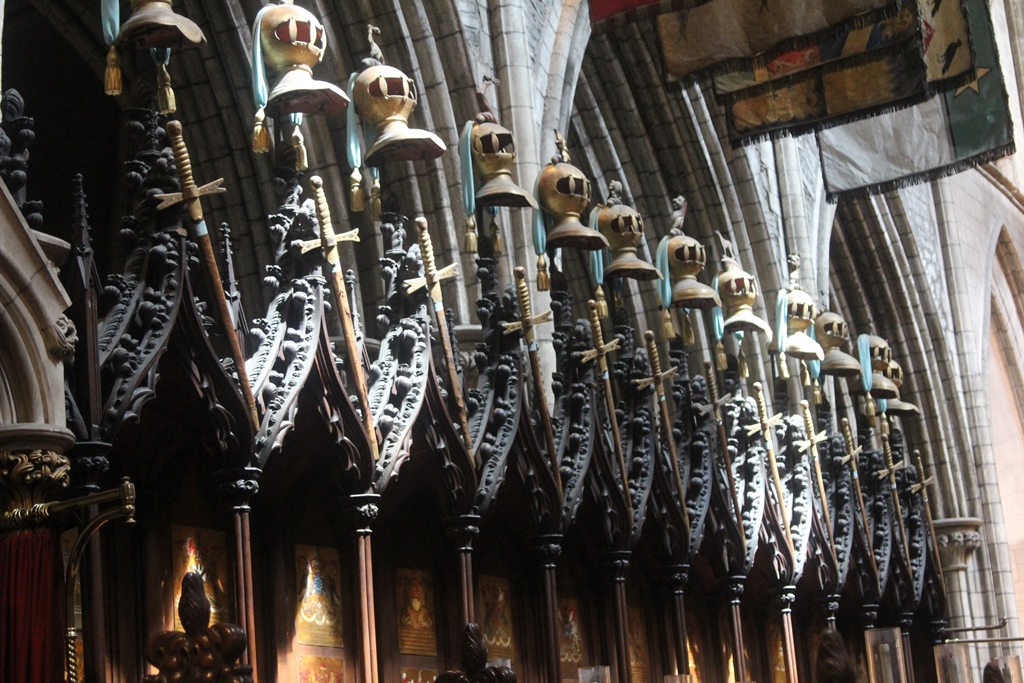
Choir
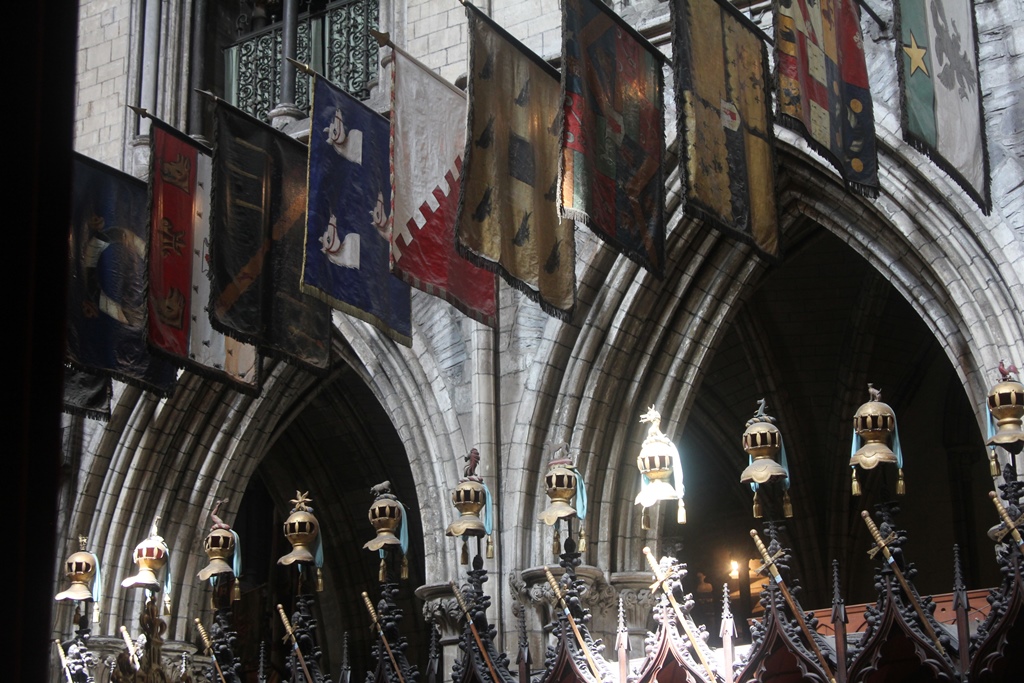
Choir
Behind the high altar we could see into a large chapel that was not open
for visitors. There were two men in the chapel who seemed to be brainstorming
something. We found out afterward that this was the Lady Chapel – a chapel
dedicated to the Virgin Mary (a Lady Chapel is apparently a common practice
among large Northern European cathedrals). For a while the St. Patrick's
Lady Chapel was known as the "French Chapel", as it was long used by French
Huguenots who had fled France for Dublin to escape persecution. As it turns
out, the Lady Chapel was closed for a major renovation shortly after our
visit – the two men may have been discussing the plans for the project. The
Lady Chapel is now open to visitors, and appears to be gorgeous, based on
pictures posted on the Internet.
Lady Chapel
As with most European cathedrals, St. Patrick's is filled with burial
places and monuments to the departed. One such monument, shown above, is
the Boyle Monument, put up in 1632 by Richard Boyle, 1st Earl of Cork.
It was originally set up against the east wall of the choir, but some were
offended by its conspicuousness (including Lord Deputy Wentworth and
Archbishop William Laud), and it was taken down in 1634, to be rebuilt
against the south wall of the chancel. This was not taken well by the
Earl, who already despised Wentworth for other reasons (e.g. property
confiscation). But he must have felt somewhat vindicated when Wentworth
was later tried, convicted and beheaded for treason following the Irish
Rebellion of 1641. In 1863, during the Guinness renovation, the monument
was moved again, this time to the west end of the cathedral, where it
remains to the present day. As an aside, one of the many figures depicted
on the monument (the one in the middle, on the lower level) is a rendering
of the Earl's youngest son Robert (the Earl and his wife, Lady Catherine,
had 14 children), who grew up to publish a fundamental law dealing with
the pressure and volume of gases (now known as Boyle's Law) in 1662. This
law is so significant that the younger Boyle is sometimes referred to as
the Father of Modern Chemistry.
Not far from the Boyle Monument is the stylistically similar memorial to
Thomas Jones, who served, among other positions, as Dean of St. Patrick's
Cathedral, Archbishop of Dublin and Lord Chancellor of Ireland. He died
in 1619.
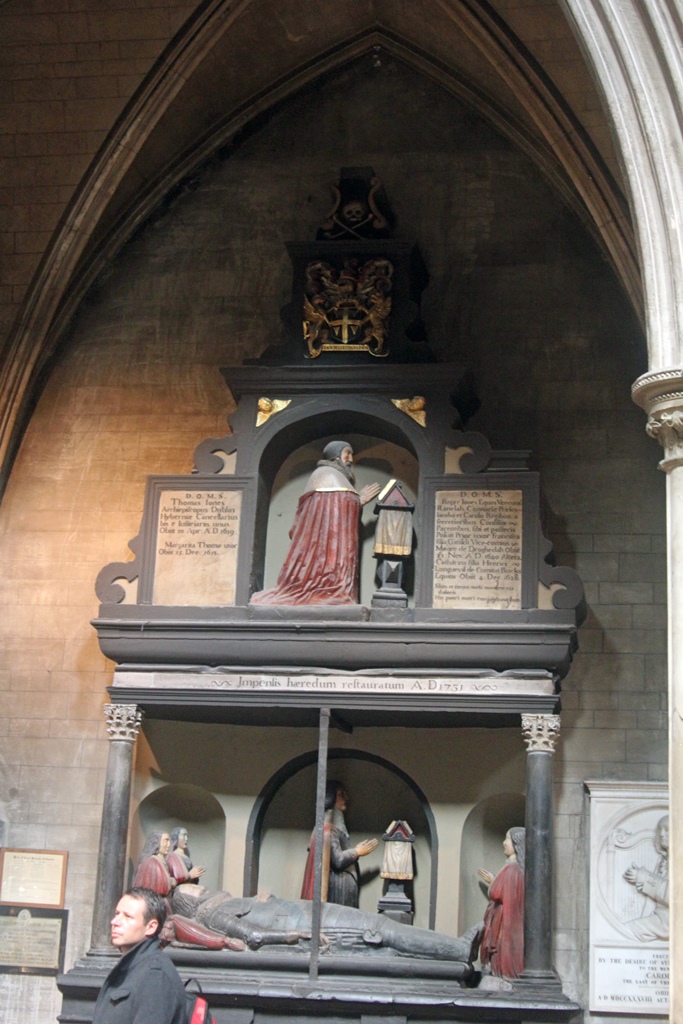
Memorial to Thomas Jones
Not all of the memorials in the cathedral involve statuary. For example, the
memorial to Edward Guinness, 1st Earl of Iveagh (1847-1927), consists of a set
of stained-glass windows. Edward was the third son of Sir Benjamin Guinness
(the Guinness behind the 1860-65 restoration), and had an active and rewarding
career of his own. He was the chief executive of Guinness from 1868 until
1889, during which the output of the brewery increased enormously. He took
over sole ownership of the company in 1876 by buying out his brother, and when
he floated two-thirds of the company in 1886, he became the richest man in
Ireland. He was a generous philanthropist, contributing heavily to slum
clearance (including one just to the north of St. Patrick's, which he
transformed into the park seen there today) and housing projects, in addition
to medical research and the British Antarctic Expedition of 1907-09 (Mount
Iveagh in Antarctica is named in his honor). He acted as High Sheriff of
County Dublin in 1885 and attained a seat in the British House of Lords in
1891. He participated in the 1917-18 Irish Convention that tried
(unsuccessfully) to find a moderate solution to the demands of Irish
nationalists, and was a personal friend of W.T. Cosgrave, who became the first
leader of the Irish Free State in 1922.
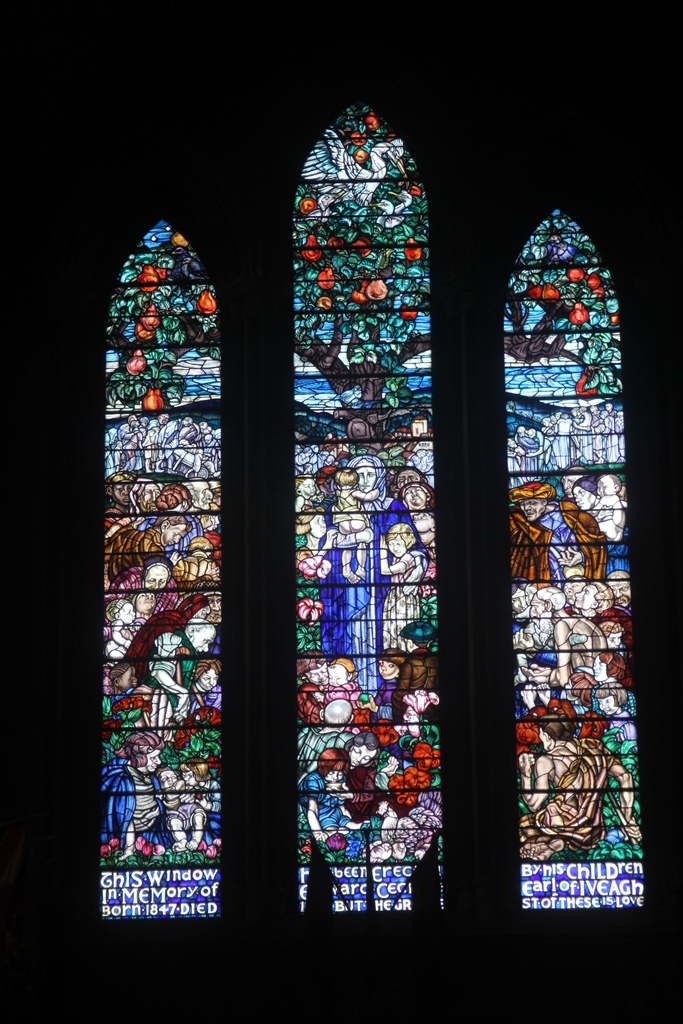
Windows in Memory of Edward Guinness
Another non-statue is a cross which was put up in memory of Sir Samuel
Ferguson (1810-1886), a barrister, antiquarian (he studied megaliths and
other archeological sites) and keeper of public records. He married into
the banking branch of the Guinness family, but is probably best
remembered as a poet, in which capacity he is considered an important
forerunner of such poets as William Butler Yeats.
Cross in Remembrance of Samuel Ferguson
But getting back to statues, the northern gallery of the cathedral is filled
with them. The most elaborate one is probably the memorial to George Nugent
Temple Grenville, 1st Marquess of Buckingham (1753-1813). George was a political
creature, attaining a seat in the House of Commons at an early age and being
briefly appointed Lord Lieutenant of Ireland in 1782. While Lord Lieutenant, he
supported increased legislative independence for Ireland, and it was he who
created the Order of Saint Patrick. He returned to British politics at the end
of 1783 but returned to the Lord Lieutenant office in 1787, which he held for
two years. But this second tour of duty was much less successful than the
first, as he made some missteps which made him thoroughly unpopular. When he
left office in 1789, he pretty much stayed out of politics for the rest of his
life. He didn't know any Guinnesses.
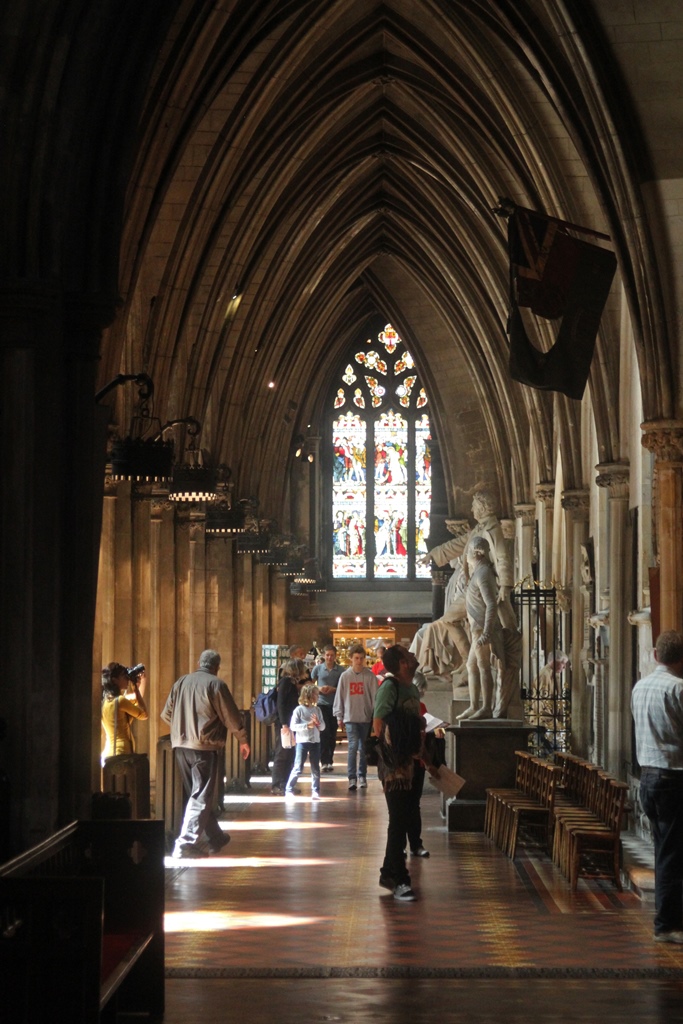
Side Gallery with Statues
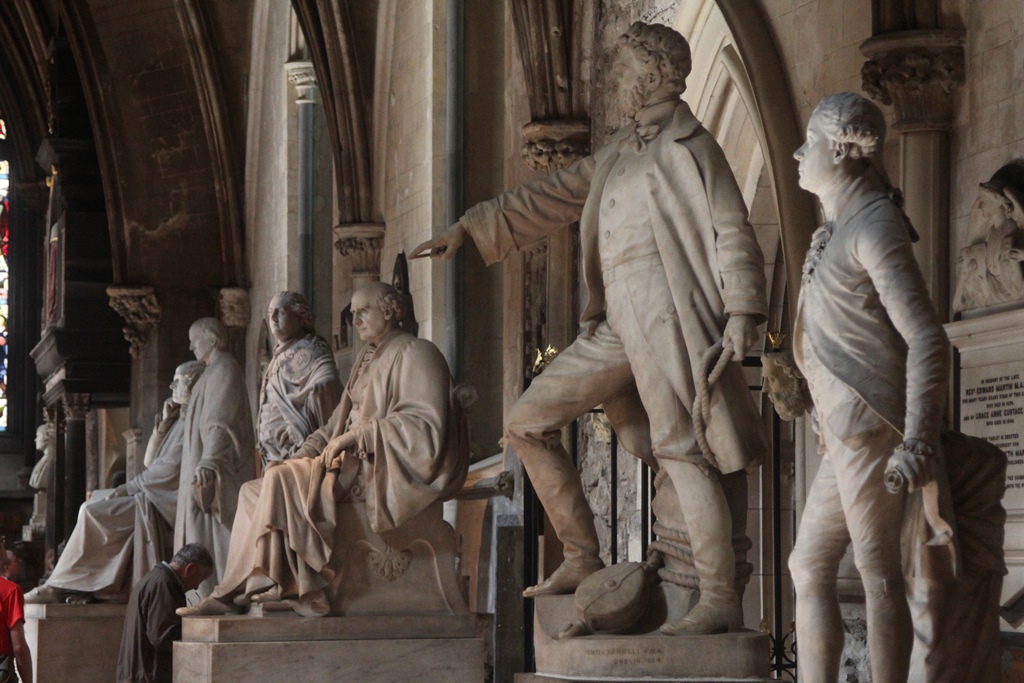
Row of Statues
Statue of George Grenville Nugent Temple
The most well-known person buried in the church is probably Jonathan Swift, who
served as the cathedral's Dean from 1713 until his death in 1745. Swift was a
prolific writer of prose, poetry, political tracts and miscellaneous
correspondence. Among his output were several works of satire, the most famous
of which was (and is) Gulliver's Travels, published in 1726.
Gulliver's Travels, written under the pseudonym "Lemuel Gulliver" (many
of his works were published under pen names), is about a young man who travels
(mostly accidentally) to many amazing places. Among these places are Lilliput
(where the people are under six inches tall), Brobdingnag (where the people are
above 70 feet tall), Laputa (a flying island), Glubbdubdrib (where Gulliver
talks to ghosts of historical figures), and the Country of the Houyhnhnms
(intelligent, talking horses, who rule stupid, deformed humans called Yahoos).
Oh, and Japan. Swift's satirical works tend to be difficult for modern-day
readers to understand as satire, as they often relate to now-obscure incidents
specific to the time in which they were written. But Gulliver's Travels
can be taken at face value as an imaginative fantasy, and people continue to
read it (and make movies of it) into the 21st Century.
Jonathan Swift is not buried alone in St. Patrick's Cathedral. He apparently
never married, but through much of his life he had a strong connection with a
woman named Esther Johnson. Swift first met Esther when he was a young man
working in England as a secretary. Esther was then eight years old, the
daughter of a woman who was acting as a companion to Swift's employer's sister.
Swift acted as Esther's tutor and mentor, and conferred upon her the nickname
"Stella". Years later, when Swift was working in Ireland and Esther had
reached the age of 20, Swift took a trip to England and brought back Esther
and Rebecca Dingley, another friend he had made while working for his former
employer. It's not clear exactly what the relationship was between Swift and
Esther. Some thought they'd been secretly married, but others thought the idea
preposterous. Esther lived with Rebecca throughout her years in Ireland, and
Swift formed and broke attachments with other women. But throughout this time,
Swift was a frequent visitor (always with Rebecca present) and correspondent
to Stella, and there is one incident in which Swift tried to discourage a
friend who was interested in marrying Esther (it's not clear whether the friend
went through with a proposal, but he ended up marrying someone else two years
later). Esther eventually died at the age of 47, and Swift was inconsolable at
this time. When Swift himself died 17 years later, he was buried next to her
in St. Patrick's Cathedral, at his request.
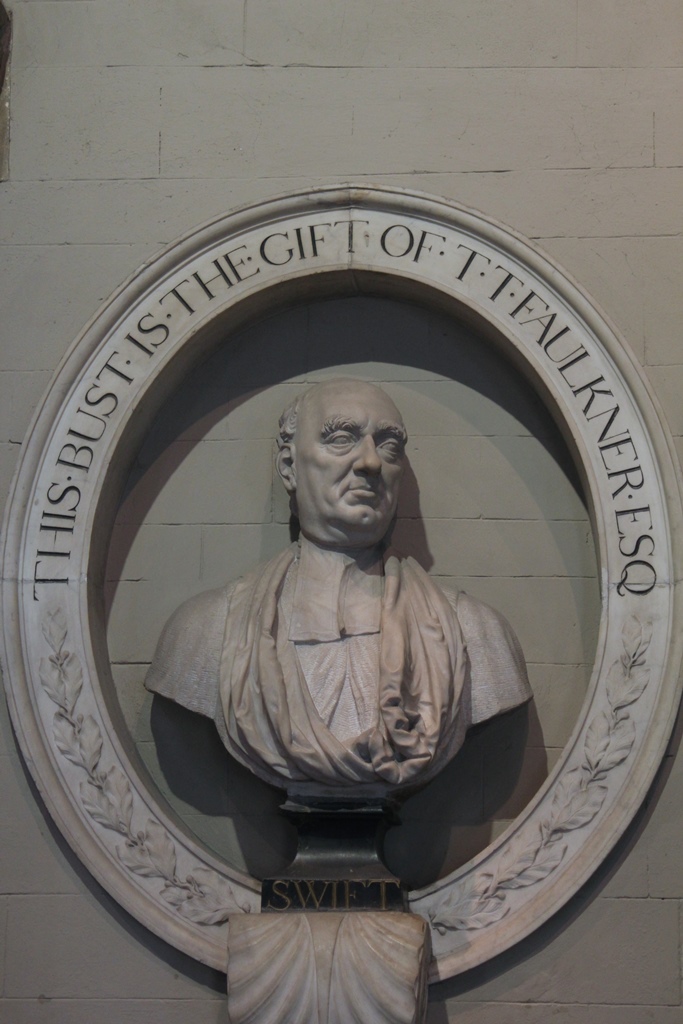
Bust of Jonathan Swift
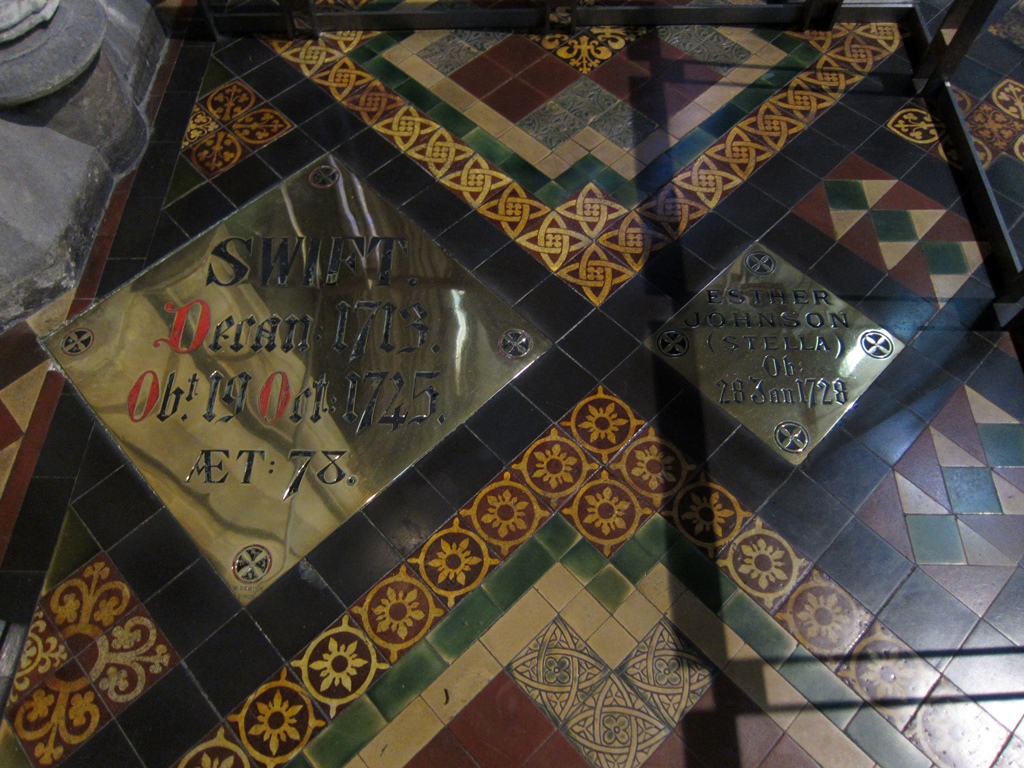
Grave Markers of Jonathan Swift and "Stella"
Death Mask of Jonathan Swift
We exited St. Patrick's Cathedral and headed in an eastward direction.
Our next destination for the day was to be the archaeology facility of
the National Museum of Ireland.

